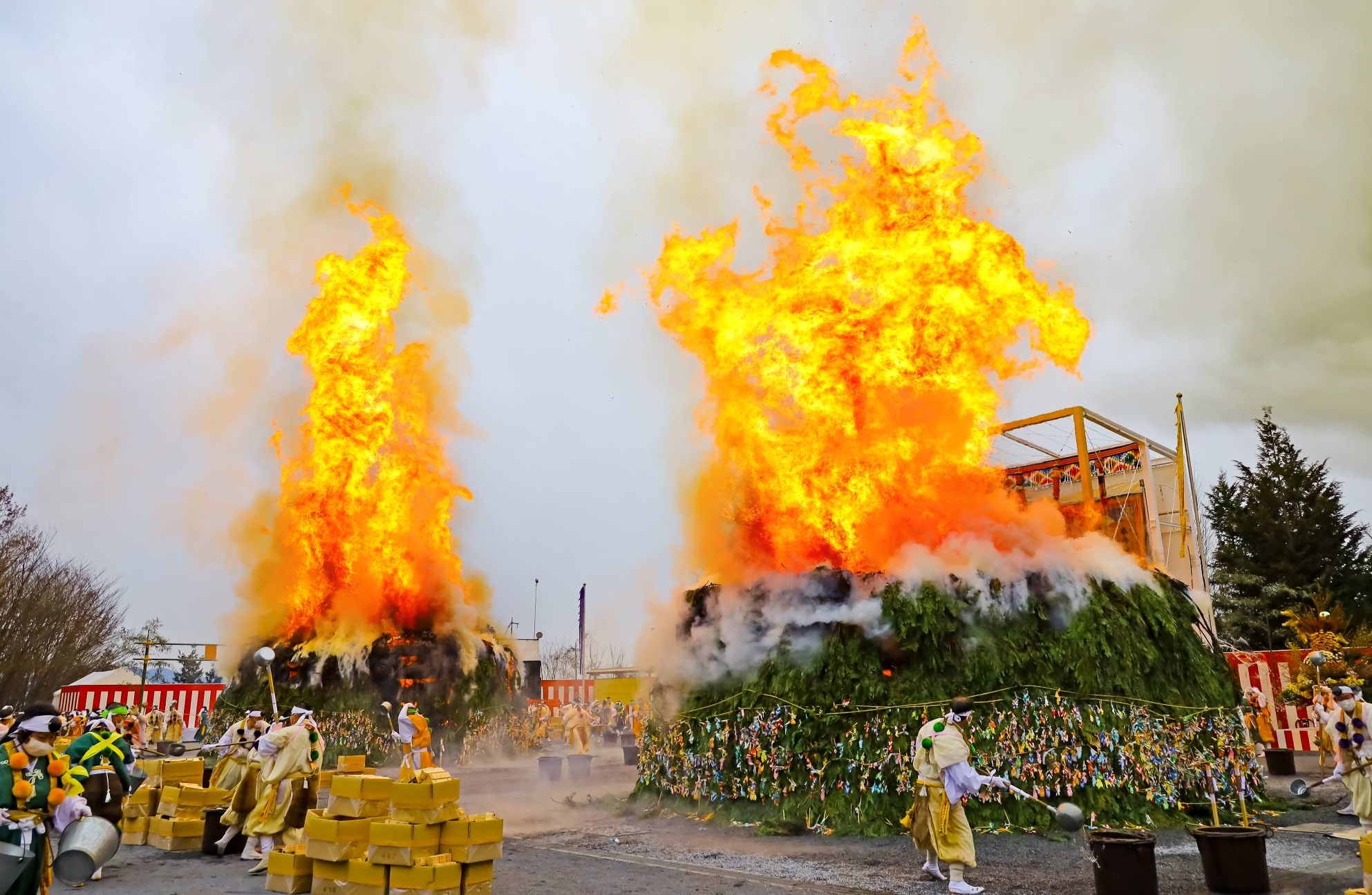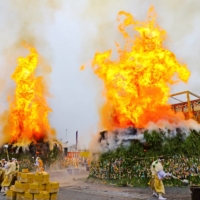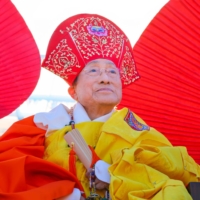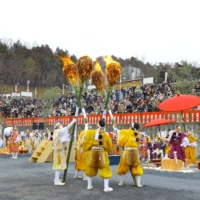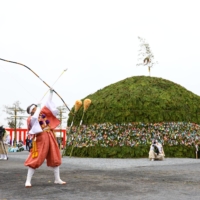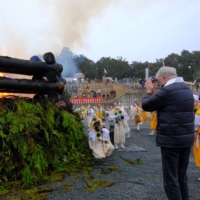A man dressed as a yamabushi (mountain priest) picks up a wooden votive tablet that has fallen beside one of two huge bonfires. He makes a silent prayer as he holds it reverently in both hands before tossing it into the flames. The gomagi joins hundreds of other such tablets being cast into the bonfires one after another as offerings for peace and health.
This scene from the Agon Shu Buddhist Association’s 49th annual Fire Rites Festival — the world’s biggest such event — shows just how seriously members of the association treat the ritual of offering prayers inscribed on gomagi that forms the festival’s centerpiece.
The Feb. 13 event was held as usual at Agon Shu’s amphitheater in the hills just to the east of Kyoto. Outwardly, the atmosphere at the festival was somewhat subdued compared with previous years due to the coronavirus pandemic. But as the yamabushi attendant’s reverential handling of the stray gomagi shows, Agon Shu’s members are as committed as ever to praying for peace and safety, in keeping with the theme of this year’s festival: “There are as many wishes as there are hopes.”
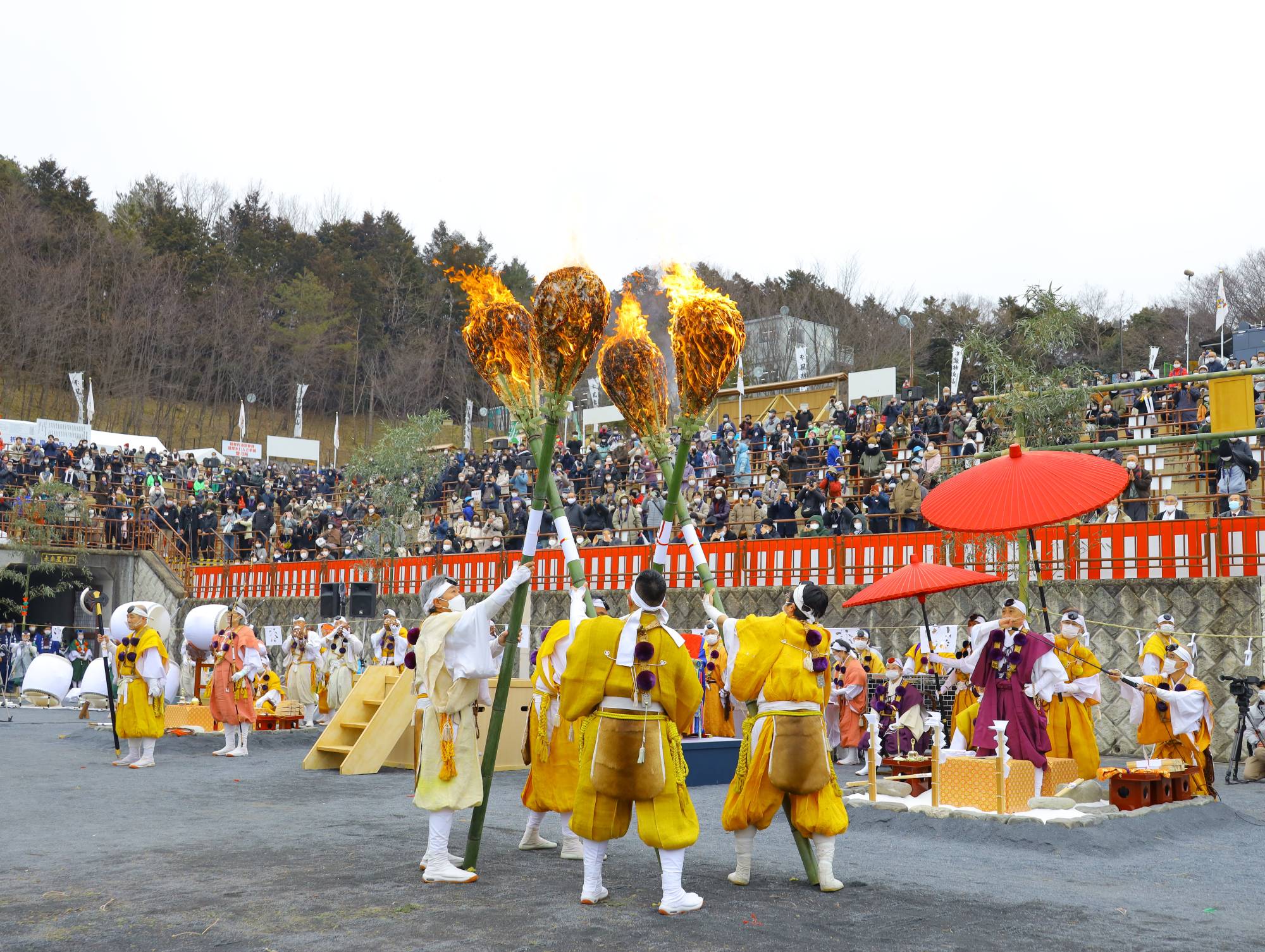
Praying for protection
They also prayed for protection from the coronavirus and natural disasters such as earthquakes, as well as offering special prayers to the maritime deity Gyoran Kannon for protection from tsunami and increasingly aggressive activities in the Sea of Japan and South China Sea by foreign powers.
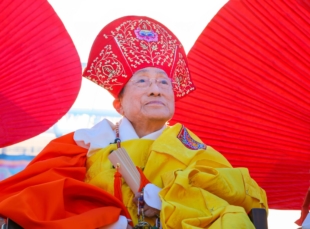
As in past years, the 2022 Fire Rites Festival began in the early morning with a procession of the Agon Shu faithful wearing colorful yamabushi costumes making their way through the thick woods surrounding the Agon Shu compound and into the amphitheater. Like last year, they kept a careful distance from each other and wore small transparent plastic face shields as precautions against infection. Occupying a place of honor in the procession was a bier bearing the ashes of the Rev. Seiyu Kiriyama, the founder and first president of the association, who passed away in 2016.
Kiriyama founded Agon Shu in 1978 after a long search for religious truth. He found it in the Agama Sutras, which contain the precepts known as the “seven systems and 37 curricula.” Believers must understand and practice them to become true Buddhists.
Community and doctrine
Since then, Agon Shu has grown into a community, or sangha, of Buddhist followers in Japan and overseas. Agon Shu’s doctrine is based on Mahayana, Theravada and esoteric Buddhism, as well as elements from spiritual traditions such as Japan’s Shinto religion and Taoism from China.
To the sound of booming symphonic music written by the late composer Toshiro Mayuzumi, the yamabushi attendants form orderly lines around the two gomadan (pyres). The shinkaidan pyre is for the prayers, requests and desires of the living, while the bukkaidan pyre is for the liberation of the spirits of the departed.
Behind the pyres is a large, colorfully decorated altar piled high with flowers and other offerings. In the middle is a relic of the Buddha himself, preserved in a small stupa that forms the centerpiece of the altar.
Sacred ritual
In the lead-up to the lighting of the bonfires, Agon Shu members performed a series of sacred rituals to ensure the festival’s success. First was a stately bugaku dance performance by two women and a man wearing colorful ancient court costumes, set to the ethereal sounds of gagaku music by composer Hideki Togi.
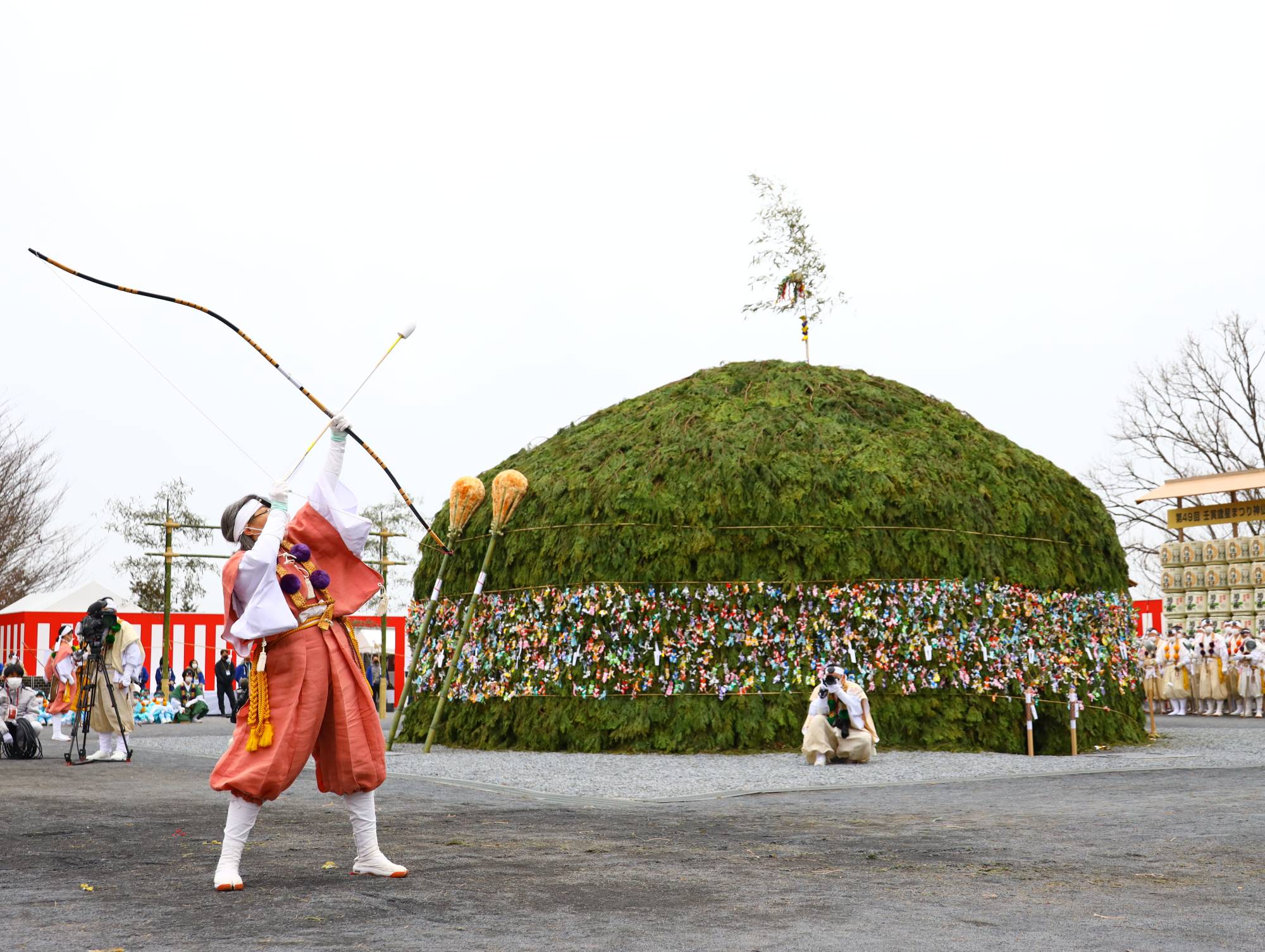
A member of the Agon Shu faithful then stepped forward, brandishing a sacred sword to dispel evil and purify the festival venue with swift, sure strokes of the blade cutting through the early morning air. Another attendant wielded a long-handled ax with a curved blade before which one could easily imagine demons cowering, and six female archers then fired arrows out of the amphitheater. A couple of projectiles with rounded wooden tips landed in the audience, adding to the excitement of the ritual. Next was a mondo (question-and-answer) exchange on religious doctrine performed by several of the faithful dressed as yamabushi.
Then, as the sound of chanting reverberated in the amphitheater, attendants set long torches alight and inserted them in the base of the gomadan, which were covered by thick green boughs. Dense columns of gray smoke began to billow out of the pyres. As the heat steadily increased, bright orange flames suddenly burst forth from their tops, causing a blast of heat to spread out from the pyres, powerfully dispelling the cold morning air. Attendants then began throwing the prayer tablets into the flames. A total of 29 million gomagi were burned in this year’s Fire Rites Festival.
Peace and love
Last year’s event saw some believers given the privilege of throwing their own prayer sticks into the shinkaidan bonfire for the first time. This writer was again given the privilege of doing so. Seen close up, the bonfires are even more impressive than when viewed from the audience area of the amphitheater. The sound of the drumming and the chanting and the heat of the flames are almost overpowering. So what to write on one’s gomagi? “Peace and love” was this writer’s choice — an obvious sentiment, perhaps, but one that never gets old, and one that we should all bear in mind in a world that doesn’t have nearly enough of either. Whether or not one belies in divine intercession, the act of writing one’s prayer on a gomagi and throwing it into the bonfire is an opportunity to focus on what’s truly important in our lives.
Attending the festival for the 11th time was TV actor Ryo Kinomoto. “Sometimes when I come here, it’s snowing, or it’s raining, or it’s sunny,” he said in his recognizable booming voice. “But every time I see the flames of the bonfires, I reflect on the past year.”
Like many of the faithful who took part in this year’s Fire Rites Festival, Naoto Gohara inscribed a prayer for world peace on his gomagi. “I want this to be a world where you can think about world peace and people other than yourself,” the Agon Shu member said.
Fumiko Takeda, who is also an Agon Shu member, said she made many wishes on her gomagi, with a special emphasis on personal health for her family in this era of the coronavirus.
A rare foreign guest
Because Japan has banned tourists from entering the country due to the spread of the omicron coronavirus variant, there were almost no non-Japanese at this year’s Fire Rites Festival. One of the few was Andrew Carter, a native of Liverpool, England, who lives in Japan.
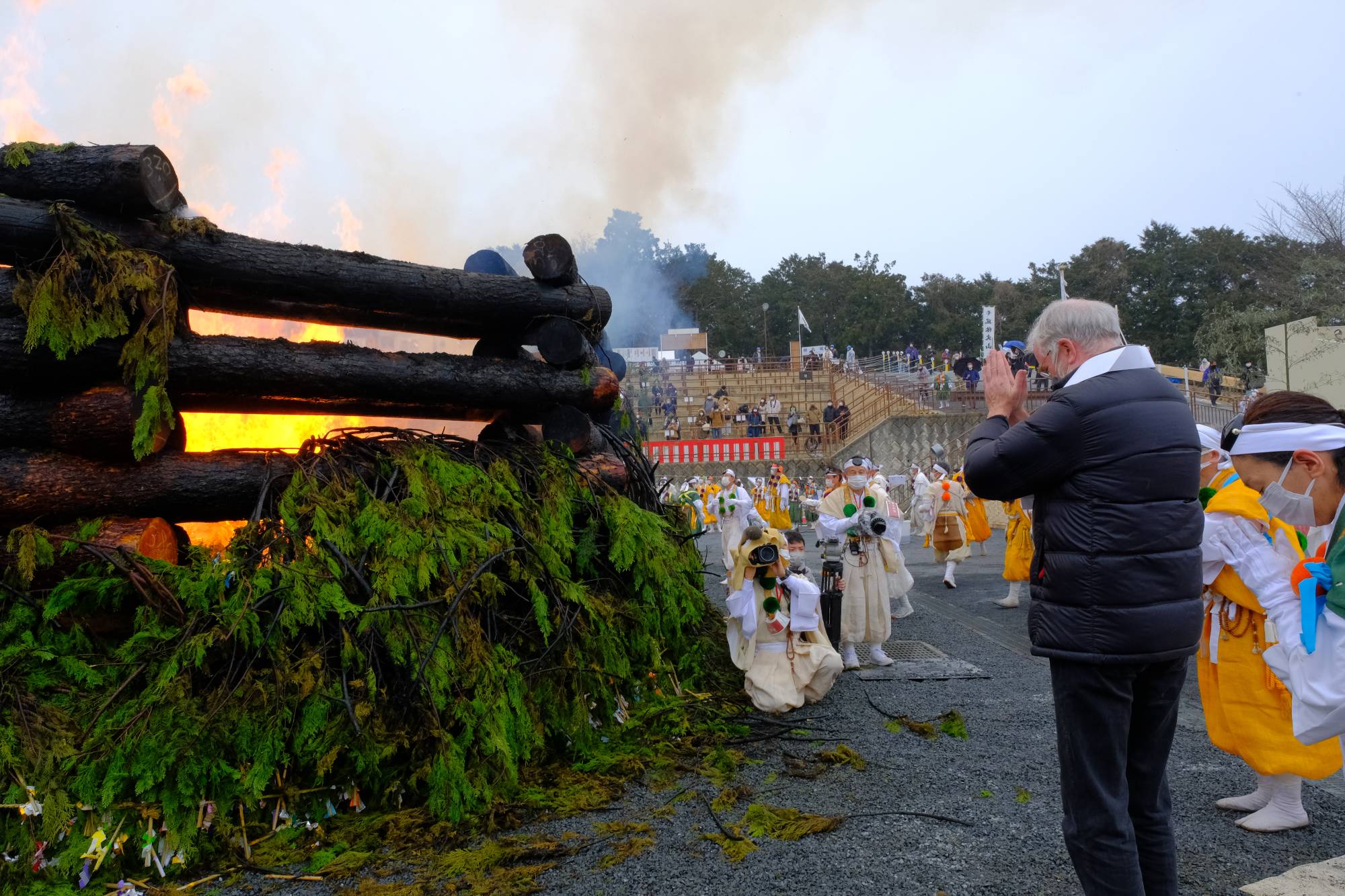
“We found this area while we were walking in the mountains a few months ago and wondered what was going on,” said Carter, who was accompanied by his wife and their infant son. “We looked into it, and heard about this festival, and so we came here today. The scale of it is very impressive.”
“Impressive” and “spectacular” are words often used to describe the Fire Rites Festival. It doesn’t matter whether you’re a first-time visitor or a veteran festivalgoer — the festival is something unique and very special indeed.



